

Icelandic food culture is deeply rooted in Scandinavian cuisine. As I mentioned in the “Brief History of the Icelandic language” episode, Iceland was settled mostly by farmers from Norway along with Vikings and some Celtic people who were made slaves after being captured by those Vikings . These Scandinavian people brought with them their cooking traditions and farming lifestyle. However, there is not much evidence of Celtic influence in Icelandic cooking.
Icelandic Food Culture During the Middle Ages
During those medieval times, settlers grew barley and oats and raised mainly cattle.They also raised other animals, like sheep, horses, pigs, chickens and goats.
The rivers in the country provided fresh water fish and people with boats could venture out to the sea to catch cod, haddock and other variety of saltwater fish. Fish was either eaten fresh or stored in salt and then dried. The salt was made by boiling salt water or burning seaweed. However, firewood in Iceland was used up quickly in most areas of the country, so dried salted fish was eventually phase out. Drying fresh fish in the wind was the dominant way of preserving this food, which is still done today to make harðfiskur. Meat was also preserved in fermented whey. Fermentation of shark, skate and herring still happen today.
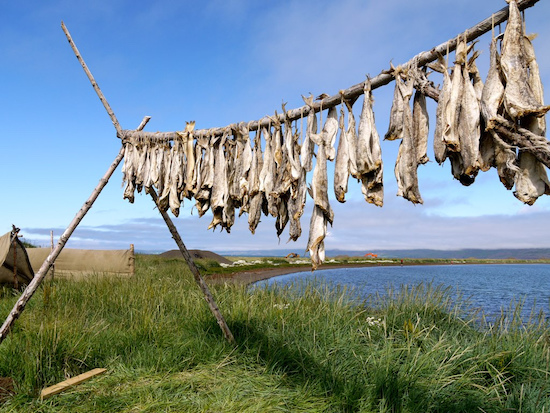
One would assume that there were a lot of fishing villages in Iceland since the beginning of when it was settled, but that was not the case. The farmers that settled there seemed to be stubbornly devoted to cultivating crops in such a harsh climate. Some were even opposed to fishing villages, mainly because fishing was considered a lot more risky when compared to farming. However, this didn’t stop people from fishing or consuming that food. While stockfish was used for trading with other countries, Iceland wasn’t heavily relying on fishing to fuel their economy until the 20th century. Meat and dairy products were what primarily made up the Icelandic diet for many centuries.
Dairy, Turf Houses & A Little Ice Age
Like many western cultures, Icelandic people love cheese and other dairy products. For centuries, they have been creating cheese from goat, sheep or cow’s milk. Interestingly, skyr, a food that Iceland is known for is said to have come from Norway but it seems that it fell off as a food in Norway, but it never disappeared from the Icelandic diet. The leftover whey from skyr was allowed to sour and then was used to preserve meat. As I mentioned in my Top 10 Icelandic foods to try episode, skyr is classified as a cheese, even though people, including myself, call it yogurt. Check out that episode to find out what the other foods are.
From settlement times until the 14 century, Icelandic people used to live in longhouses that placed the kitchen in the center of the house in order to heat it up. Earth ovens were used for making bread and cooking meat. During sometime in the 14th century, those longhouses were replaced by turf houses. These houses were smaller and the kitchen had its own room with a raised stone or hearth. Hooks were hung from above to hold pots at the desired height from the fire. During this time there was also shift from eating two meals a day to eating three.
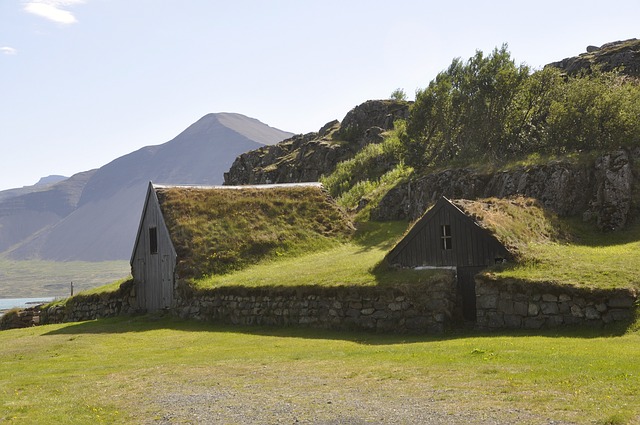
During medieval times, grains were more easily incorporated into the Icelandic diet. On average, it was a warmer time, which allowed for barley and other grains to be grown in Iceland. However, that all changed when the country and other parts of Europe and North America experienced a “Little Ice Age”. The cooler climate started in the 14th century and continued until halfway through the 19 century. While there is some debate about why this cooling period happened, some causes that have been proposed include more volcanic activity, changes in the ocean circulation, cyclical lows in solar radiation, as well as variations in the Earth’s orbit and axial tilt. The colder climate made it harder to yield a lot of grain and Icelandic people started to depend more on trade to get access to different grains.
The Impact of Trade on Icelandic Food Culture
Merchant ships from many European countries would stop in Iceland to trade a variety of items such as stale beer, biscuits, grains and chewing tobacco for Icelandic stockfish, also known as harðfiskur, and knitted wool. However, in 1602 the Danish King created a trade monopoly in Iceland by forcing Icelandic people to only buy from Danish merchants. While illegal trade did continue, this trade monopoly directly impacted the type of grain and cereal Icelandic people had access to.
One result from the monopoly, is that Icelandic farmers started to grow a type of rye that was mostly found in Denmark. This rye was used to make Brennivín, Icelandic schnapps, and rúgbrauð, a dark and kind of sweet rye bread made in this country. Another result from the monopoly imposed by the Danish King is the influence of Denmark on Iceland’s food culture. The first written cookbooks in Iceland were published in the 18th century and were a collection of Danish recipes. Most of Iceland’s traditional cookie and cake recipes come from Denmark. Funny enough, some Danish baking traditions are still practiced in Iceland but have died out in Denmark.
In the late 1700s, the monopoly had dissolved because the ban on buying from other merchants had been lifted. Unfortunately, a mere ten years later, Laki erupted. This was the most devastating volcanic eruption that Iceland has experienced, so far, since it was settled in the 9 century. Crops, livestock and a large part of the population were wiped out. While this was devastating for the country, the people pushed on. I dedicated a full podcast episode to this eruption because it was so devastating, Check out the link in the show notes to listen to it.
Self Reliance Grows in Iceland
In the early 1800s, the Napoleonic Wars kept merchant ships from reaching Iceland. This sparked a movement toward self reliance in the country. People started to focus on producing and consuming locally grown food. There was also a move in the 1900s toward preserving traditional Icelandic methods. Home economic schools for women were created around the country and the culinary traditions that were written down emphasized fresh ingredients, especially from the sea. Between the 19th and 20th century is when Iceland saw the major shift from a mainly meat and dairy diet to one that included more fish and vegetables.
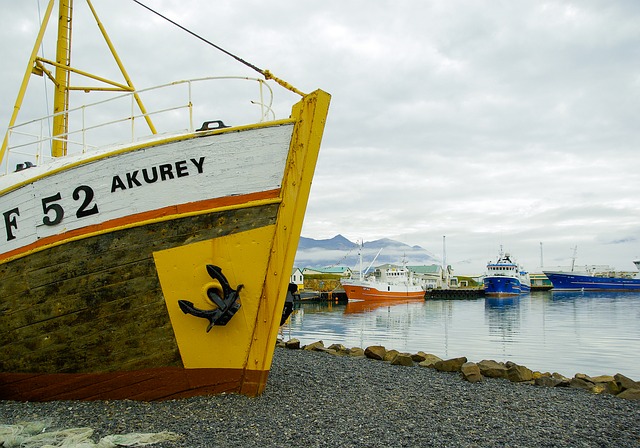
A little before World War 1, is when Iceland started to fish on an industrial scale and fish in the country was quite cheap. Fishing villages popped up around the country and Icelanders started eating a lot of fish. In fact, up until the 1990’s they were consuming more fish per capita than any other European country.
Nostalgia for Traditional Icelandic Food
Even though fish was all the rage, there were some people in the country that didn’t want to completely abandon consuming the traditional food that their ancestors ate to survive during the settlement times. During the 1940s, regional associations were formed in Reykjavík that organized regional midwinter festivals that served fermented shark, lambs head and other traditional foods in a buffet.
These festivals eventually became Þorrablót, which are celebrated during the month of Þorri. If you are curious about other holidays in Iceland, I talk more about Þorrabót in my podcast episode about Icelandic traditions, holidays and celebrations. I’ll have a link to it in the show notes of this episode if you want to check it out.
The Presence of More Foreign Food
World War 2 brought a lot of changes to Iceland. The occupation by the British in 1940 resulted in fish and chips shops opening up in Reykjavík. When the U.S. military took over in 1941, the soldiers brought hamburgers and other food that was known to most Icelandic people. This time period is what eventually sparked the growth of U.S. fast food culture in this country.
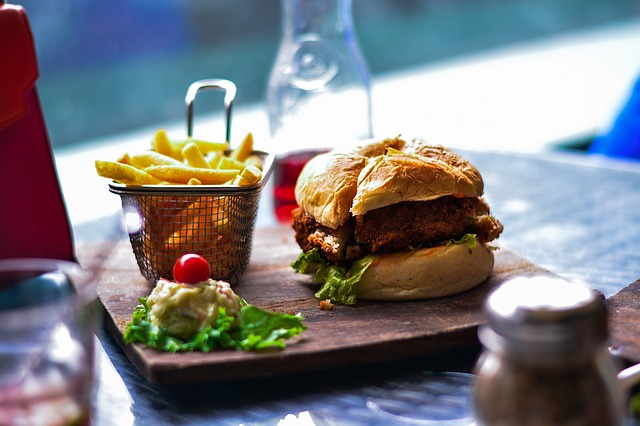
Even though Icelandic people could get foreign food downtown, they were still eating Danish influenced food at home. Two very popular cookbooks at the time were Matreiðslubók fyrir fátæka og ríka (A Cookbook for Poor and Rich; the subsequent editions were just called Matreiðslubók) by Jónina Sigurðarsdóttir and Matur og Drykkur by Helga Sigurðardóttir. Both women had been educated in Denmark but there is an Icelandic twist to their recipes.
Variety in Icelandic Food Culture Starts to Grow
For many years, vegetables were seen as a supplement in the Icelandic diet. They were good for making real food last longer when you couldn’t afford to buy more meat or fish. However, Matur og Drykkur cookbook helped to introduce more vegetable varieties into Icelandic homes. Potatoes were considered a staple in the Icelandic diet and some Icelandic people today believe that their meal is not complete if it does not have potatoes in it. One thing that I find quite fascinating is that use of spices was still quite limited. Paprika was being used during the 1940’s but not a lot of dry herbs. Some fresh herbs, like parsley, chives and dill, were used in meals but that was about it.
During the 1960’s is when traveling abroad started to become more popular in Iceland. This allowed for Icelandic people to be introduced to a variety of foods, including shrimp cocktail sauce. It might seem strange but Icelandic people are big fans of cocktail sauce, and sauces in general. The Icelandic version is used in many different recipes.
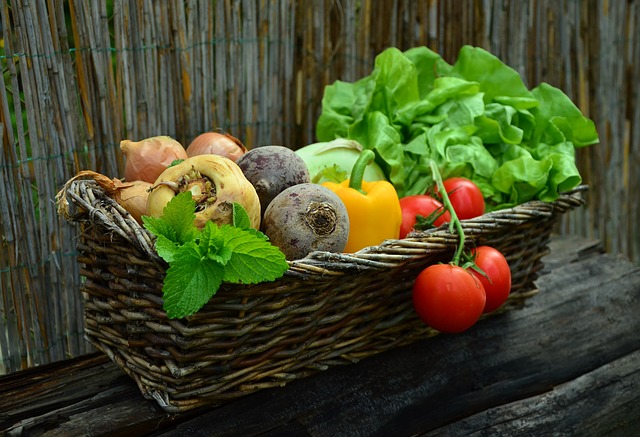
The increase in growing and eating more vegetables in Iceland started in the 1970’s. In 1977, about 8,000 tons of vegetables had been produced. That number jumped up to 30,000 tons in 2007. Thankfully, Iceland’s cold climate reduces the need for pesticides to be used by farmers. Most, if not all, vegetables that are produced on a mass scale are grown in greenhouses in Iceland.
Cabbage, turnips, rutabaga, tomatoes and cucumbers were grown and sold. While bananas were grown in Iceland for a short time, most fruit is imported. You can pick and eat delicious wild blueberries during the summer here. The 20th century brought better temperatures in Iceland for growing barley. This was the first time since the Middle Ages that it was possible to grow this grain for human consumption in Iceland.
Modern Icelandic Food
The 1980’s is when a lot of new restaurants in Iceland started to pop up. Previous to this, eating out was not a huge part of the culture unless it was a special occasion.
While Icelandic people do appreciate and celebrate their traditional food history and culture, modern day cuisine emphasizes local and fresh food that is infused with creativity. It also has a lot more vegetables. Restaurants like Nostra, Kol, Fiskmarkaðurinn, and Matarkjallarinn are serving up fine dining experiences with a modern Icelandic twist. Here is a link to TripAdvisor’s list of the best food restaurants based on your budget.
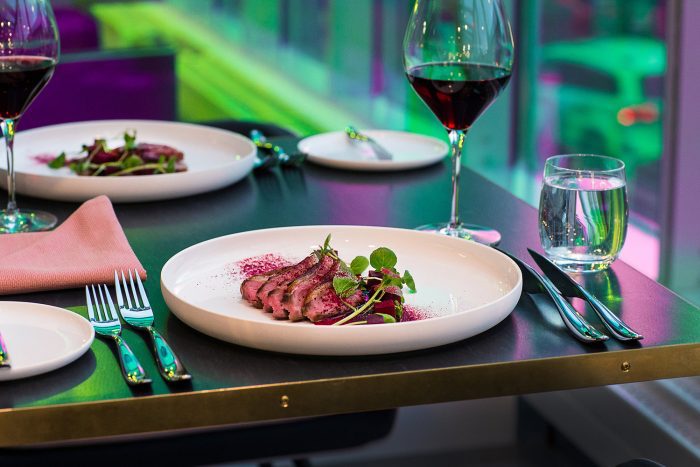
Nostra in Reykjavík
What I find fascinating is the selection of food available for people from different cultures, diet restrictions and lifestyles. So many restaurants have vegan and vegetarian options on their menus. I have seen many gluten free products in the supermarkets and I even recently saw a keto item on the menu at Gló, an Icelandic restaurant that serves delicious, fresh and healthy food. While Icelandic based cuisine still dominates the eating culture here, it is very easy to find pizza, burgers, dishes from different Asian countries and a variety of food imported from around the world. I think it is great that Icelandic people are preserving many of their traditions regarding food but are still being open to accepting and trying different foods.
In Icelandic homes, local game meat has become more popular and people are using new methods to cook traditional meals. While lamb is still consumed, many people are buying a lot more chicken than lamb. Fish is eaten quite a bit but it is usually not eaten multiple times a day as it was during the time period when eating fish was at its all time high in Iceland.
Random fact of the episode
The horses and sheep in Iceland have been raised in isolation since medieval times. Some people call them the settlement breed or viking breed. Icelandic law prohibits importing horses into the country and any horse that has been exported are not allowed to come back. This prevents diseases that could be present in animals that live outside of the country from spreading to animals that live in Iceland.
Icelandic word of the episode = Bygg
Let’s be social! Here is where you can connect with me on social media platforms:
I hope you enjoyed this episode that is chock full of information about the evolution of Icelandic food culture. I release a new podcast episode every week. Make sure you are subscribed to the All Things Iceland podcast so you don’t miss new episodes. If the platform you are listening to this podcast on allows you to leave a review, please do so, if you haven’t already.
Þakka þér kærlega fyrir að hlusta (og að lesa) og sjáumst fljótlega
Thank you kindly for listening (and reading) and see you soon!